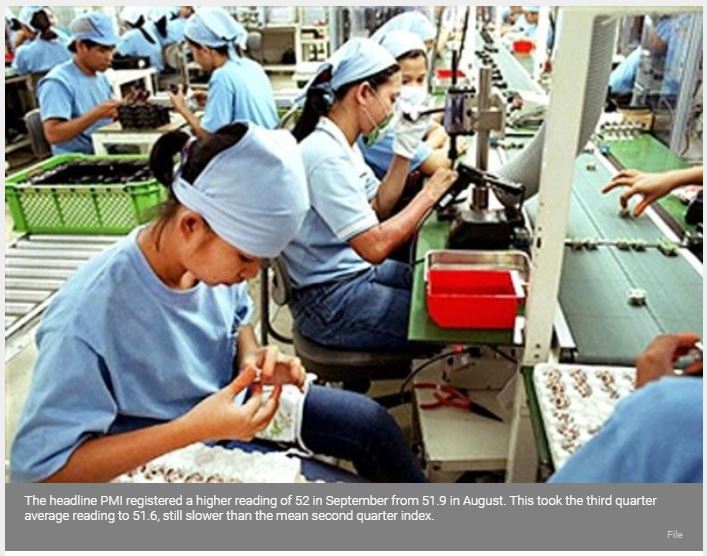Philippines: Local manufacturing grows at modest pace in September
MANILA, Philippines — The domestic manufacturing sector grew at a moderate pace in September, signalling “resilient” expansion in the months ahead, according to the latest reading of the Nikkei Philippines Manufacturing Purchasing Managers’ Index (PMI).
The headline PMI registered a higher reading of 52 in September from 51.9 in August. This took the third quarter average reading to 51.6, still slower than the mean second quarter index.
But the latest PMI reading puts the sector well within expansion territory as a reading of below 50 indicates contraction. The headline PMI provides a quick overview of the health of the manufacturing sector based on output, new orders, job creation, inventories and delivery times.
Moreover, stronger domestic demand and improved operating conditions compared with those of neighboring countries in the ASEAN region made Philippine manufacturing the best performing in the region during the month.
In September, local manufacturers recorded further increases in new orders despite faltering foreign demand, suggesting domestic consumption is driving growth.
In response to higher sales, firms raised production and hired more workers. Despite higher output, factories were able to handle more orders at current capacity because of higher productivity and more efficient workflow, said IHS Markit, the firm that compiled the data for the PMI.
Firms also increased purchases of inputs although at a modest rate as inflationary pressures remained because of supply shortages, a weaker peso, and higher prices of imported raw materials such as steel, electronic and electrical components, plastics, paper, sugar and fuel.
Longer delivery times for supplies were also experienced during the month because of typhoon-related disruptions and port congestions.
To protect their profit margins, firms once again passed on higher costs to customers.
“Philippine manufacturing likely grew at a slower pace in the third quarter, compared to the second quarter, according to the Nikkei PMI survey. However, September survey data suggest that growth in the coming months is likely to be resilient, while strong cost inflation remains a key concern. In general, Filipino manufacturing firms are optimistic about the business outlook in the year ahead,” said IHS Markit principal economist Bernard Aw.
Despite the more optimistic outlook for the Philippine manufacturing sector, IHS Markit said inflationary pressures would continue to weigh on producers and consumers in the months ahead.
“On the inflation front, another steep rise in input costs saw firms raising selling prices at the second- fastest rate in the survey history during September. However, inflation was partly driven by typhoon- related factors. That said, a weaker peso, supply shortages, higher global commodity prices and the TRAIN law continued to drive inflation higher. As such, the latest PMI price gauges raised doubts about prospects that consumer inflation will reach a peak in September, suggesting instead that inflation could remain elevated in the months ahead,” said Aw.
Region-wise, manufacturing conditions in ASEAN slowed down in September because of slower increases in both output, new orders and cost inflation.
The headline ASEAN Manufacturing PMI fell from 51 in August to 50.5 in September. This took the average quarterly PMI reading to 50.6, lower than the previous quarter’s average.
The Philippines topped the ASEAN Manufacturing PMI rankings in September. It was followed by Malaysia, Vietnam, Indonesia and Thailand. Singapore and Myanmar registered declining manufacturing conditions during the reference period.
“Strong cost pressures persisted across the region, with several countries reporting sharp increases in input prices due to unfavorable exchange rates against the dollar,” said Aw.
Source: https://www.philstar.com/business/2018/10/02/1856374/local-manufacturing-grows-modest-pace-september#k9sxwso6tF1OdjVI.99


 Thailand
Thailand




